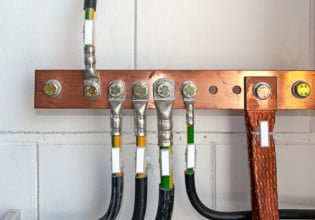Researchers at the University of Alberta have demonstrated single-wire no return (SWNR) quasi-wireless power delivery to a variety of electronic devices. Research Associate, Charles Van Neste with Professor Thomas Thundat's Research Group, has developed a quasi-wireless power system requiring only a single connection to feed into a surface, which can provide a charge to electrical devices. This energy system, called SWNR, produces a charged surface where devices containing the coiled-wire receiver can be energized, such as a light or a cell phone. This technology could reduce wiring costs by 50% in homes, planes, and automobiles because the return conductor is replaced by the surface.
“We started by heating oil sands in large containers with our single wire systems. Then we developed an inexpensive heating pad to interface with our technology in an effort to speed up evaporation of tailings water by adding electricity. From there it became a power mat for charging devices,†Van Neste said. “What we’re doing essentially is transferring power without a return conductor. It uses an invisible circuit element called stray capacitance to complete the circuit which allows electricity over surfaces rather than through a plug.â€
“The electricity bounces back and forth like a paddle ball inside the receiver and the surface becomes part of the connection and bounce back. So it creates a standing wave where the charging surface is near the nodal point, turning conductive objects into charging surfaces,†Van Neste said.
It may be hard to make the connections as to how this is possible, but this method of electricity transfer isn’t a new-age discovery. Van Neste dug out primary sources from Nikola Tesla’s work that is over 100 years old. Tesla is a Serbian American inventor and engineer who designed the modern ac electricity supply system. In 1893, he researched wireless lighting and electricity distribution and as a result made early pronouncements on the possibility of wireless communication devices. Tesla gained a reputation as a “mad scientist†with his creative inventions. SWNR power systems are still hard for people, even other engineers, to grapple with.
Van Neste pieced together Tesla’s research with the help of the Tesla Memorial Society of New York’s online archive “the Tesla Collection†who painstakingly digitized Tesla’s work. Where Tesla applied the technology to only wires, the University of Alberta research team developed one aspect of the technology to power lamps and cell phones over surfaces.
Place a lamp with the special internal receiver onto a table that has a controlled power source input, and the lamp lights up. If you touch the lamp, it turns off and if you touch the table, you don’t feel any electrical charge. “People working in radio and television distribution have been trying to prevent standing waves for over 100 years. A quasi-wireless power system operating below 10 Megahertz is designed to meet the strict guidelines for electro-magnetic exposure set by Heath Canada,†Van Neste explained.






